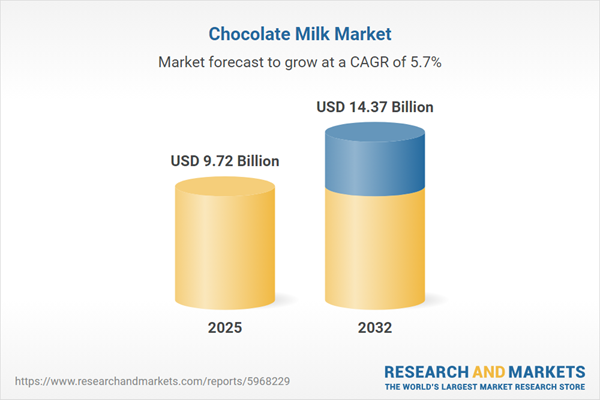Speak directly to the analyst to clarify any post sales queries you may have.
Senior executives navigating the chocolate milk market face shifting consumer expectations, rapid technological advances, and evolving regulatory frameworks. Continued adaptation is central for maintaining competitiveness as trends in health, convenience, and sustainability increasingly shape decision-making across the sector.
Market Snapshot: Growth and Forecast for the Chocolate Milk Market
The chocolate milk market maintains upward momentum, with market value rising from USD 9.21 billion in 2024 to USD 9.72 billion by 2025, and forecasted to reach USD 14.37 billion by 2032. This reflects a compound annual growth rate (CAGR) of 5.71%. This positive outlook is underpinned by consistent product innovation, robust portfolio management, and supply chain improvements. Leading brands are implementing digital transformation strategies, investing in customer engagement tools, and seeking operational efficiencies. The combined emphasis on differentiation, technology adoption, and streamlined logistics enables organizations to better withstand supply chain volatility and seize emerging opportunities in the chocolate milk sector.
Scope & Segmentation: Strategic Dimensions of the Chocolate Milk Market
- Product Types: Dairy-based chocolate milk leads, but plant-based alternatives are gaining momentum among consumers pursuing vegan, lactose-free, or health-focused options.
- Packaging Formats: Flexible containers, including bottles, cans, cartons, and pouches, enable tailored retail channel strategies, support sustainability, and promote brand distinction on shelves and in digital marketplaces.
- Form & Preparation: The sector spans frozen, syrup, powder, and ready-to-drink formats, addressing diverse consumption behaviors and supporting adaptive logistics across new and established sales channels.
- Demographics: Innovation aligns chocolate milk products with the needs of specific consumer groups such as adults, children, and seniors, addressing variations in health and lifestyle requirements.
- End Use: Chocolate milk is consumed in households, retail and foodservice environments, and institutional settings, driving ongoing enhancements in both product formulations and packaging technology.
- Distribution Channels: Integration of e-commerce with traditional stores allows brands to respond nimbly to changing customer buying patterns and makes market entry more accessible for emerging participants.
- Geographies: Market activities are distributed across the Americas, Europe, Middle East & Africa, and Asia-Pacific, with strong presence and expansion efforts in countries such as the United States, China, India, Germany, Brazil, and Australia.
- Leading Brands: Major industry participants include Dairy Farmers of America, Müller Holding GmbH, Arla Foods amba, Barry Callebaut, Bega Group, Cargill, Chocoladefabriken Lindt & Sprüngli, Clover Farms, Dana Incorporated, Danone, Ferrero, Grupo Arcor, Gujarat Cooperative Milk Marketing Federation, Mars, Maryland & Virginia Milk Producers Cooperative, Meiji, Nestlé, Parle Products, Royal FrieslandCampina, Saputo, Straus Family Creamery, The Coca-Cola Company, The Hershey Company, The Kraft Heinz Company, and Yili Group.
Key Takeaways: Strategic Insights for Senior Leaders
- Drive product innovation focused on health-conscious formulations and transparent labeling to meet evolving standards and build consumer trust.
- Embed sustainability within every aspect of the value chain, emphasizing ethical sourcing and advanced packaging methods for long-term growth and risk management.
- Expand plant-based offerings to capture shifting dietary trends and engage previously underserved consumer segments.
- Implement robust omnichannel approaches connecting digital and physical sales channels, reflecting customer preferences and broadening reach.
- Enhance supply chain resilience by fostering diversified supplier relationships and agile logistics to better navigate volatility.
- Utilize analytics and artificial intelligence for demand monitoring, targeted product launches, and adaptive responses tailored to varied distributor and client requirements.
Tariff Impact: Navigating U.S. Policy Shifts
Upcoming U.S. tariffs on key ingredients for chocolate milk are creating new operational challenges. Major companies are adapting by emphasizing domestic procurement, strengthening alliances with suppliers, and implementing flexible production processes to ensure regulatory compliance and effective cost containment amid changing policy conditions.
Methodology & Data Sources
This report uses direct interviews with executives and supply chain partners, supported by verified data from trade journals, audited company financials, and regulatory filings. Rigorous analysis enables actionable insights tailored for leadership roles in the chocolate milk sector.
Chocolate Milk Market: Why This Report Matters
- Provides market frameworks and benchmarks for senior leaders to prioritize innovation in product and sustainability practices, supporting long-term adaptation.
- Enables effective identification and mitigation of regulatory and market risks, allowing swift responses to sector and operational uncertainty.
- Supports businesses managing digital transition and increased process automation, enhancing reliability and operational continuity.
Conclusion
Strategic innovation and focused investment will enable organizations in the chocolate milk market to adapt to evolving expectations and strengthen their position amidst an ever-changing global landscape.
Additional Product Information:
- Purchase of this report includes 1 year online access with quarterly updates.
- This report can be updated on request. Please contact our Customer Experience team using the Ask a Question widget on our website.
Table of Contents
3. Executive Summary
4. Market Overview
7. Cumulative Impact of Artificial Intelligence 2025
Companies Mentioned
The companies profiled in this Chocolate Milk market report include:- Dairy Farmers of America, Inc.
- Müller Holding GmbH
- Arla Foods amba
- Barry Callebaut
- Bega Group
- Cargill, Incorporated
- Chocoladefabriken Lindt & Sprüngli AG
- Clover Farms
- Dana Incorporated
- Danone S.A.
- Ferrero SpA
- Grupo Arcor S.A.
- Gujarat Cooperative Milk Marketing Federation
- Mars Inc.
- Maryland & Virginia Milk Producers Cooperative Association, Inc.
- Meiji Co., Ltd.
- Nestlé S.A.
- Parle Products Limited
- Royal FrieslandCampina N.V.
- Saputo Inc.
- Straus Family Creamery
- The Coca-Cola Company
- The Hershey Company
- The Kraft Heinz Company
- Yili Group
Table Information
| Report Attribute | Details |
|---|---|
| No. of Pages | 193 |
| Published | November 2025 |
| Forecast Period | 2025 - 2032 |
| Estimated Market Value ( USD | $ 9.72 Billion |
| Forecasted Market Value ( USD | $ 14.37 Billion |
| Compound Annual Growth Rate | 5.7% |
| Regions Covered | Global |
| No. of Companies Mentioned | 26 |









